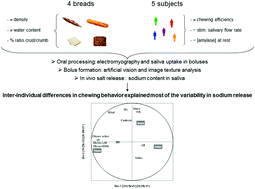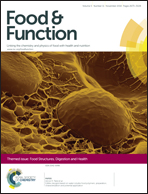The impact of mastication, salivation and food bolus formation on salt release during bread consumption
Abstract
Health authorities recommend higher fibre and lower salt content in bread products. However, these basic ingredients of bread composition are multifunctional, and important changes in their content influence the texture, flavour and acceptability of the product. This study was designed to investigate the link between oral processing, bolus formation and sodium release during the consumption of four different breads that varied in composition and structure. Chewing behaviour was determined by surface electromyography, and salivation was quantified from the water content of the boluses collected. The kinetics of bread degradation during food bolus formation was characterised by measuring the bolus heterogeneity by texture image analysis, and sodium release into the saliva was quantified. Mastication and salivation varied between products and between subjects, thus highlighting different bolus formation strategies. In vivo salt release was mainly explained by mastication parameters. The initial slope of sodium release increased when the chewing muscles’ activity increased, and the maximum sodium concentration was reached later when more masticatory cycles were required to reach the swallowing point.


 Please wait while we load your content...
Please wait while we load your content...